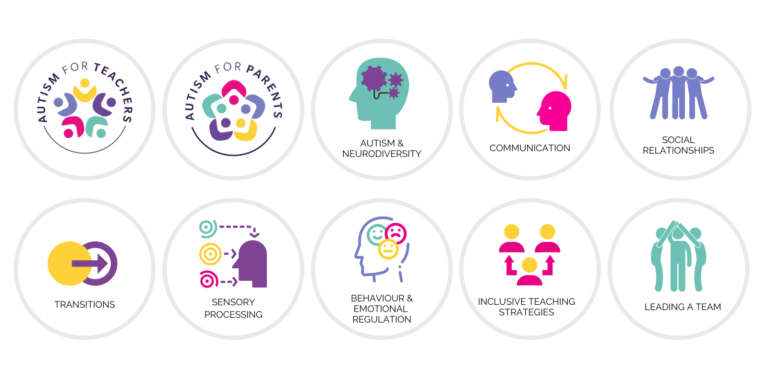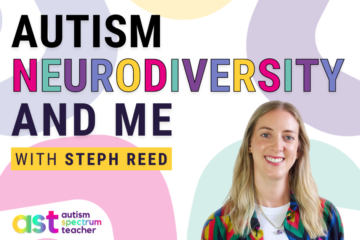Table of Contents
Podcast: Play in new window | Download
Subscribe: Spotify
Podcast Episode Notes
Here is the first episode of the Autism Spectrum Teacher Podcast #1: Successful Teaching and Support Strategies (that will not just benefit autistic children, but all children!)
Being as it is the first episode, I have given an introduction to myself and why I started the podcast.
My vision for the podcast is:
Sharing knowledge, information and practical advice related to autism through having conversations with autistic individuals, parents, carers, teachers, educational professionals and service providers.
The first episode is just me and I will be discussing successful teaching and support strategies that will not just benefit autistic children, but all children. I have based these strategies on regular themes that come up during my outreach and consultancy visits to different schools.
Future episodes will include special guests!
#1: Inclusive teaching and support strategies (that will not just benefit autistic children, but all children!)
1. Always Think about the Sensory Input in the Environment
The sensory input in the environment can really have an impact on an individual. There is often a lot of sensory input going on around us all of the time. In today’s classrooms, there is a lot of sensory stimuli. For example; busy, colourful classroom displays, lots of resources around the room on tables and shelves, bright lights, lots of different smells and different sounds. Sometimes, autistic children can find it difficult to block out different stimuli or experience the input differently to you and much more sensitively.
There is what’s known as hypersensitivity, which is being very, very sensitive to sensory input, or hyposensitivity which is being under sensitive or perhaps not register specific sensory input. Every individual is different and can be both over sensitive and under sensitive to different sensory input. We always need to remember that everyone is experiencing the sensory input around them differently and this is especially true for an autistic individual. I will give examples about how you may observe this and potential strategies to adapt the environment to support different sensory needs and in turn, promote a conducive learning environment.
I discuss more about sensory needs in the blog post – ‘Sensory needs, autism and our class ‘exercise’ activity’ and ‘Sensory equipment for children with autism’.
FREE EBOOK Supporting Sensory Needs, grab your copy here.
2. Adapting Our Use of Language and Communication
A child will get a diagnosis of autism because they have differences in their receptive and perhaps their use of expressive language. Each individual will have very different communication needs. It could be that one person doesn’t develop any verbal language and has challenges with understanding the language and communication used by others. Perhaps another person has very advanced expressive language skills and can talk very well. However, they may experience difficulties in understanding non-verbal communication or some of the language from others around them.
I will discuss different strategies to enhance your own communication, such as using very specific language, ensuring your communication is clear, reducing language to the important key words, using visuals or objects to enhance language, using Makaton sign, giving time to process information after giving a child an instruction, using one instruction at a time and other strategies related to adapting our language and communication to support a child.
I discuss this further in the blog post ‘Why the choice of language you use to communicate with an autistic child is so important’.
3. Be Consistent
Consistency in our approach is extremely important. Ensuring there is familiarity and routine can enhance predictability. This can be especially important for an autistic child. A lack of consistency, whether it be in the way you manage behaviour, your use of language or the morning routine, will increase anxiety and confusion for any child. I will discuss examples of this.
4. Be Organised
Organisation is extremely important. I will give examples of how being ultra organised made an impact on my lessons and some strategies I used for keeping organised and ensuring the school day runs smoothly!
There is further information about the organisation of a classroom in my blog post ‘What to consider when setting up a classroom for children with autism’.
5. Focus on Developing Emotional Regulation
Emotion regulation is our ability to recognise and respond to our emotional state. For many children with autism (in fact many children in general) it can be challenging to recognise and safely manage these emotions. It is therefore extremely important that we teach children how to recognise their feelings and then ensure they have strategies to know how to deal with those emotions. I will give some ideas as to how to develop emotional recognition as well as how to develop strategies for children to regulate their emotion.
I discuss emotional regulation further in my blog post ‘Emotional regulation: Teaching autistic children to recognise and respond to their emotion’ as well as ‘Emotional regulation & communication table supports for children with autism’.
6. Focus on Developing Social Interaction
It is important to model social interaction through playing with the children. Some children may find it difficult in knowing how to interact or how to interact ‘appropriately’. You therefore will need to explicitly teach different social situations and social skills. Modelling play and language will really help the children see how to do this. Social Stories are a great resource for teaching personalised, social skills. I am a big fan of the ‘Intensive Interaction’ approach in developing early communication, interaction and relationships.
I discuss Intensive Interaction further in the blog post ‘Intensive Interaction and early communication development’.
7. Try to Understand the Reason Behind Behaviour
There could be a wide range of reasons as to why a child is behaving in a particular way.
Try to understand what the child may be experiencing, looking deeper at the context and situation. Of course, this is often an interpretation, but it will help you to work out what may be causing the distress, in order to identify ways to help the child.
Could it be a result of:
- Communication needs (e.g. are they frustrated that they have not been any to communicate something to you). Could you therefore offer ways to help them communicate?
- Social understanding (e.g. are they wanting to interact with you but are not sure how to do this ‘appropriately’). Could you therefore show them how to interact?
- Sensory processing (e.g. are they sensitive to something in the environment that is causing them distress). Could you therefore put sensory supports in place?
- Avoidance (do they not want to be in that room or take part in that activity). Look at why they want to avoid it, is it because they are not interested?
- Objects/ activities (e.g. has their favourite toy been taken away from them without warning or can they see an object that they want). Therefore could you ensure they are effectively prepared for when the activity will finish, perhaps using a visual support such as a sand timer?
- Medical needs (e.g. are they not feeling well?)
- Anxiety (what is contributing to their anxiety?)
8. Use Transition Supports
I provide further information on visual timetables in my blog post ‘Visual timetables for children with autism’.
9. Structure Lessons and Tasks Visually
Providing a visual structure to lessons and tasks supports children to understand the different parts of the task and what is expected to take place before the lesson ends. An example of this is using pictures or symbols of the different parts of the task. I will discuss why this is important and how to implement this in your classroom or service.
I provide further information about lesson structure in my blog post ‘The importance of using a visual lesson schedule for children with autism’ and ‘How to structure a lesson or activity for pupils with autism’.
10. Make Learning Engaging and Motivating
Grab children’s focus and attention by using exciting and engaging resources and lesson themes. Using the child’s interests or favourite characters in learning tasks can really help engage the child in the learning. I discuss a few ideas of how to do this.
There is more information about making learning engaging in my blog post ‘Attention Autism stage 1: attention bucket video and comments from creator Gina Davies’ and ‘Personalised learning: Using children’s interests to motivate them!’
11. Model How To Do Something
It is more effective to model or show a child how to do something, rather than relying on just telling them. When giving an instruction to a child or introducing a lesson, always model or show the child how to do it. I will discuss how this can really promote independence.
I hope you found the podcast useful! If you did, make sure you subscribe in your podcast app to get the next episode sent straight to your device!


5 Comments
Laura · January 9, 2019 at 1:34 pm
Loved the podcast! I would absolutely love if you did a podcast about teaching younger children with autism. I am teaching in an Early Intervention Class (3 to 5 year old children with autism) and would love to hear any advice/information that you might have.
Steph Reed · January 18, 2019 at 4:29 pm
Thank you Laura! That is a great idea! I’d also welcome any guests on the podcast, so let me know if you would like to have a recorded conversation about this topic! I think it would be interesting for both of us to talk about this! steph@autismspectrumteacher.com
Rachael Longworth · May 6, 2020 at 12:03 pm
Hi Steph,
Just listened to this podcast.
I thoroughly enjoyed it. Full of useful tips, links and advice. I am going to recommend this to my friends. I will continue to listen in
Thank you.
Rachel Norman · October 18, 2021 at 1:38 pm
I found this podcast so useful!! I have a ASD child and currently working to get him the right support in school but also have a job interview for a secondary school as a TA in the SEN area so will use some of these examples on the day!! Thank you!!
Steph Reed · October 27, 2021 at 11:48 am
Pleased to hear Rachel!
Comments are closed.